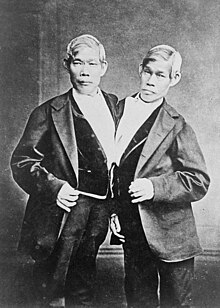Life
The Bunker brothers were born on May 11, 1811 in Siam (now Thailand), in the province of Samutsongkram, to a fisherman and a mother (Nok or นาก [Nak] in Thai). Because of their Chinese heritage, they were known as the "Chinese Twins" in Siam. They were joined at the sternum by a small piece of cartilage. Their livers were fused but independently complete. Although 19th century medicine did not have the means to do so, modern surgical techniques would have easily allowed them to be separated.In 1829, they were "discovered" in Siam by British merchant Robert Hunter and exhibited as a curiosity during a world tour. Upon termination of their contract with their discoverer, they successfully went into business for themselves. In 1839, while visiting Wilkesboro, North Carolina, the twins were attracted to the area and settled on a 110-acre (0.45 km2) farm in nearby Traphill, becoming naturalized United States citizens.
Determined to start living a normal life as much as possible, the brothers settled on a plantation, bought slaves , and adopted the name "Bunker". On April 13, 1843, they married two sisters: Chang to Adelaide Yates and Eng to Sarah Anne Yates. Interestingly, this made their respective children double first cousins. In addition, because Chang and Eng were identical twins, their children were genetically equivalent to half-siblings, thus making them genetically related in the same manner as half-siblings who are also first cousins.
Their Traphill home is where they shared a bed built for four. Chang and his wife had 10 children; Eng and his wife had 11. In time, the wives squabbled and eventually two separate households were set up just west of Mount Airy, North Carolina in the community of White Plains – the twins would alternate spending three days at each home. During the American Civil War Chang's son Christopher and Eng's son Stephen both fought for the Confederacy. Chang and Eng lost part of their property as a result of the war, and were very bitter in their denunciation of the government in consequence.
After the war, they again resorted to public exhibitions, but were not very successful. They always maintained a high character for integrity and fair dealing, and were much esteemed by their neighbors. The twins died on the same day in January 1874. Chang, who had contracted pneumonia, died rather suddenly in his sleep. Eng awoke to find his brother dead, and called for his wife and children to attend to him. A doctor was summoned to perform an emergency separation, but Eng refused to be separated from his dead brother. He died three hours later. (An urban legend claims that Eng died of fright upon finding Chang dead, but this was not the case.) Chang's widow died on April 29, 1892 and Eng's widow died on May 21, 1917.
Legacy
The fused liver of the Bunker brothers was preserved and is currently on display at the Mütter Museum in Philadelphia, Pennsylvania. Numerous artifacts of the twins, including some of their personal artifacts and their travel ledger, are displayed in the North Carolina Collection Gallery in Wilson Library at the University of North Carolina at Chapel Hill. This includes the original watercolor portrait of Chang and Eng from 1836.The short story The Siamese Twins by Mark Twain was based on the Bunkers. In 1996, BBC Radio 4 broadcast a 90-minute radio play called United States about the lives and deaths of Chang and Eng Bunker. The writer was Tony Coult and the director was Andy Jordan. Transmission was on June 17, with a cast that included Bert Kwouk and Ozzie Yue as the twins. A Singapore musical based on the life of the twins, Chang & Eng, was directed by Ekachai Uekrongtham and written by Ming Wong, with music by Ken Low. Chang & Eng premiered in 1997 and has since been performed around Asia, starring Robin Goh as Chang Bunker, Sing Seng Kwang as Eng Bunker, and Selena Tan as their mother, Nok. Subsequent productions starred Edmund Toh as Chang Bunker and RJ Rosales as Eng Bunker. The best-selling and multiple-award-winning 2000 novel Chang and Eng by Darin Strauss was based on the life of the famous Bunker twins. The film rights to the novel were purchased by award-winning filmmaking team Gary Oldman and Douglas Urbanski. Oldman is currently working on the screenplay and will also direct.
Chang and Eng Bunker had at least 21 children between them; their descendants, including several sets of non-conjoined twins, now number just over 1,500. United States Air Force Major General Caleb V. Haynes was a grandson of Chang Bunker through his daughter Margaret Elizabeth "Lizzie" Bunker. Haynes's son, Vance Haynes, earned a doctorate in geosciences, performed foundational fieldwork at Sandia Cave to determine the timeline of human migration through North America, and served as professor at several universities. Alex Sink, Chief Financial Officer of Florida, is a great-granddaughter of Chang Bunker, and was the Democratic nominee in the 2010 Florida gubernatorial election.
A play by noted Bay Area playwright Philip Kan Gotanda and based on the lives of the Bunker Twins is currently being produced in workshop form at UC Berkeley and will be produced on their main stage in the spring of 2011.


No comments:
Post a Comment